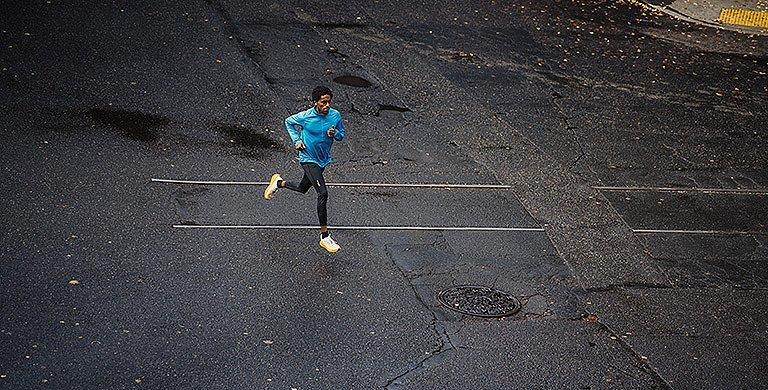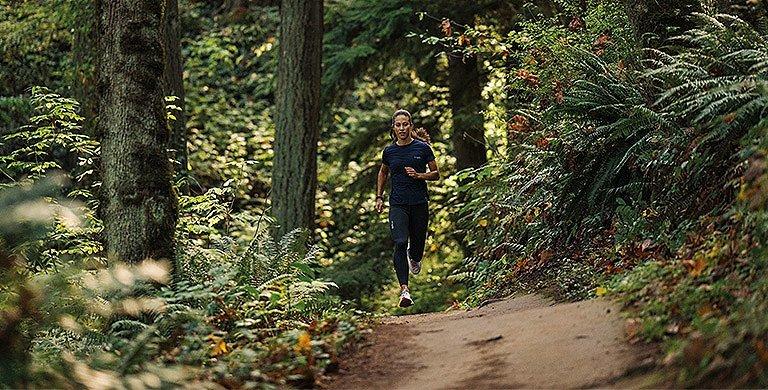TRAIL RUNNING
Unlock Your Running Potential: Cross-Training for Runners
If you’re a runner who’s weary of hitting plateaus, suffering from nagging injuries, or just feeling like your training isn’t hitting your targets, cross-training might be the answer.
BY: NANCY BOUCHARD
Running is tough on the body—it’s high-impact and repetitive. Without variety, runners risk overuse injuries like tendonitis or joint pain. Cross-training is like switching up your playlist—when you throw in new tunes, it keeps the rhythm fresh, avoids monotony, and keeps you moving without burning out. Whether you're looking to avoid injuries, improve performance, or simply add some variety to your routine, cross-training is your secret recovery remix.
Consider cross-training your fitness side hustle. The goal is the same, but you’re approaching it with different tactics. If you're dealing with injuries, boredom, or plateauing performance, cross-training can help. Any activity that’s not running but still makes you a stronger, more balanced runner is a step in the right direction. From yoga to plyometrics to weight training, cross-training exposes your body to new movement patterns, keeping things fresh and functional. It isn’t one-size-fits-all—it depends on your goals, the benefits you’re after, and what’s available to you. But one thing’s for sure: it introduces new challenges and helps your body adapt and thrive.
Consider cross-training your fitness side hustle. The goal is the same, but you’re approaching it with different tactics. If you're dealing with injuries, boredom, or plateauing performance, cross-training can help. Any activity that’s not running but still makes you a stronger, more balanced runner is a step in the right direction. From yoga to plyometrics to weight training, cross-training exposes your body to new movement patterns, keeping things fresh and functional. It isn’t one-size-fits-all—it depends on your goals, the benefits you’re after, and what’s available to you. But one thing’s for sure: it introduces new challenges and helps your body adapt and thrive.
Why Cross-Training Matters
The repetitive motion of running can take a serious toll on your body. While the meditative rhythm of running is what most of us seek, the constant strain on the same muscles and joints can lead to overuse injuries. Cross-training allows your muscles and joints to recover by giving them a break and challenging your body in different ways.
Cross-training teaches your body to adapt and handle different types of stress, which is essential for long-term progress. Tim Evens, MS, DPT, and avid runner and adventurer, emphasizes that variety is key to preventing injuries and improving performance. "Running is highly repetitive and can cause musculoskeletal overload resulting in tendonitis, joint pain, inflammation, and pain,” explains Evens. “Cross-training can expose the body to diverse and dynamic loading patterns, helping the body adapt to a more diverse set of loads."
By exposing your body to varied movement patterns and types of resistance, cross-training promotes muscular balance, prevents injuries, and enhances performance. It spreads the workload across different muscle groups, letting your running-specific muscles rest while keeping you strong and resilient. It’s not just recovery—it’s a performance enhancer that prepares you for the next run.
Cross-training teaches your body to adapt and handle different types of stress, which is essential for long-term progress. Tim Evens, MS, DPT, and avid runner and adventurer, emphasizes that variety is key to preventing injuries and improving performance. "Running is highly repetitive and can cause musculoskeletal overload resulting in tendonitis, joint pain, inflammation, and pain,” explains Evens. “Cross-training can expose the body to diverse and dynamic loading patterns, helping the body adapt to a more diverse set of loads."
By exposing your body to varied movement patterns and types of resistance, cross-training promotes muscular balance, prevents injuries, and enhances performance. It spreads the workload across different muscle groups, letting your running-specific muscles rest while keeping you strong and resilient. It’s not just recovery—it’s a performance enhancer that prepares you for the next run.
The Best Cross-Training Exercises for Runners
Swimming
- Why it’s great: Swimming is a low-impact, full-body workout that boosts cardiovascular fitness and keeps your joints mobile. It’s perfect for giving your legs a break while staying active. Plus, if your gym has a cold plunge, hot tub, sauna, steam room, that checks the cross-training box as well.
- Best for: Recovery days or runners dealing with joint pain. It’s a great way to get in full-body strength without the strain of pounding the pavement.
Cycling
- Why it’s great: Cycling—road, mountain bike, or in the gym builds strength in your quads and hamstrings while giving your joints a break from the impact of running. It’s a great way to keep your aerobic fitness up without the wear and tear on your legs. Find a scenic route and take in the views, or if the weather is poor, hit the gym for a spin class.
- Best for: Road runners who want a solid cardio workout with less impact. It’s a fun way to mix things up if you’re used to running the same routes every day.
Climbing
- Why it’s great: Rock climbing challenges you mentally and physically. It pushes you to face fears, problem-solve, and overcome obstacles, building mental toughness that translates to running. Plus, it strengthens your upper body and core, balancing out muscles used during running. Whether you climb indoors, outdoors, or even at a winter ice park, there’s a huge sense of accomplishment when you conquer a tough route. It's the kind of confidence boost that’ll make your next run feel easier.
- Best for: Reducing the risk of overuse injuries and strengthening areas that don’t get as much attention while running, like your core and upper body.
Yoga
- Why it’s great: Yoga enhances flexibility, core strength, and mindfulness. It gives your body the balance it needs for better running posture and helps with recovery by releasing muscle tension. As Evens advises: “Start with a simple vinyasa flow class once a week to expose your body to every movement it needs.”
- Best for: Runners of all levels. It’s especially helpful for improving flexibility and preventing tightness that can lead to injury.
Strength Training
- Why it’s great: Strength training builds power, balance, and running efficiency. It’s key for injury prevention. Focusing on posterior chain muscles (like your glutes, hamstrings, and calves) helps runners with stability and power. Engaging your anterior chain (such as the hip flexors, quads, and shins) supports proper form and balance during your stride, ultimately improving running efficiency. Stronger muscles mean better performance and fewer injuries. As you get stronger, you'll see improvements not just in your running times, but also in your posture and overall energy. The stronger your foundation, the better your running performance.
- Best for: Injury prevention and boosting running economy. Focus on single-leg exercises, squats, lunges, and deadlifts to help you run more efficiently.
Plyometrics
- Why it’s great: plyometrics, or jump training, helps build explosive power and speed. It improves running efficiency by teaching your muscles to work with more force in less time, translating to quicker, more powerful strides. The high-intensity nature of plyometrics makes it feel like a mini workout challenge each time. As you get better, you’ll notice your strides getting longer and faster. Start with basic exercises like jump squats or box jumps. These explosive movements build power in your legs, improving stride efficiency and speed. As you get stronger, you’ll notice that your sprints and hill climbs will become easier and faster.
- Best for: Trail and track runners looking to increase speed and agility. Perfect for those who want to build explosive power and elevate their running to the next level.
How to Incorporate Cross-Training into Your Routine
Evens suggests starting with one day a week: “You’ll see benefits even from just one yoga, plyo, or weight session weekly. But remember, cross-training stress adds up, so budget recovery time.” For those with higher mileage or training for a race, one to three sessions per week can be optimal—adjust intensity based on running goals.
When it comes to cross-training, keep it balanced! Don’t overdo it—cross-training is meant to complement running, not replace it. And listen to your body; if you’ve got nagging injuries, be mindful not to push them further. Tim notes that cross-training shouldn't overload problem areas. Also, don’t skip your rest days—your body needs time to chill, adapt, and rebuild to come back stronger. But don’t forget the do’s either: ease into new activities to avoid overloading your body and focus on solid form during strength or plyometric exercises to stay injury-free. And most importantly, prioritize recovery—sleep, hydration, and stretching are your best friends in the process. Keep it fresh, fun, and focused on recovery, and you’ll be running stronger than ever.
When it comes to cross-training, keep it balanced! Don’t overdo it—cross-training is meant to complement running, not replace it. And listen to your body; if you’ve got nagging injuries, be mindful not to push them further. Tim notes that cross-training shouldn't overload problem areas. Also, don’t skip your rest days—your body needs time to chill, adapt, and rebuild to come back stronger. But don’t forget the do’s either: ease into new activities to avoid overloading your body and focus on solid form during strength or plyometric exercises to stay injury-free. And most importantly, prioritize recovery—sleep, hydration, and stretching are your best friends in the process. Keep it fresh, fun, and focused on recovery, and you’ll be running stronger than ever.
Create Your Cross-Training Plan
- Balance It Out: Prioritize low-impact activities like swimming or yoga on recovery days.
- Match Your Goals:
- Trail Runners: Ski touring or plyometrics to train balance and stability.
- Road Runners: Yoga or cycling for flexibility and endurance.
- Track Runners: Explosive movements like box jumps for speed.
- Mix It Up: Don’t be afraid to explore new activities like rock climbing for full-body strength.
- Remember the Basics
Sleep is essential for muscle repair and energy restoration. Avoid screens, caffeine, and heavy meals before bed.
Hydration supports circulation, reduces fatigue, and flushes out toxins. Stay hydrated before, during, and after workouts.
Exellent nutrition when you are training for any running race. Remember that fuel equals being faster.
Stretching reduces tension and improves flexibility. Make it part of your post-workout routine.
Why Recovery Is Non-Negotiable
Cross-training is the unsung hero of running. It’s not just about preventing injuries or recovering faster—it’s about becoming a stronger, more well-rounded athlete. As Tim notes “Recovery is just as critical as the workout itself.” Whether you're tackling trails or chasing PRs on the track, incorporating activities like yoga, swimming, or strength training can take your running to the next level. “We’re dynamic creatures capable of more than just one form of movement. The strengths you gain from one sport can make you more resilient in another,” explains Evens. So, go ahead. Mix it up, recover like a pro, and watch your running take off.
For your next running race or cross-training adventure, check out Columbia’s running apparel, shoes and accessories.
Every Surface Is a Trail!
Every Surface Is a Trail!



